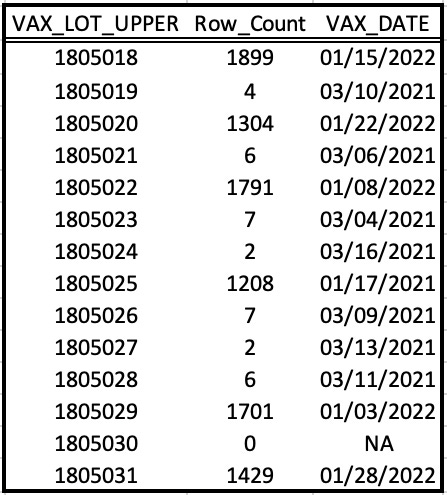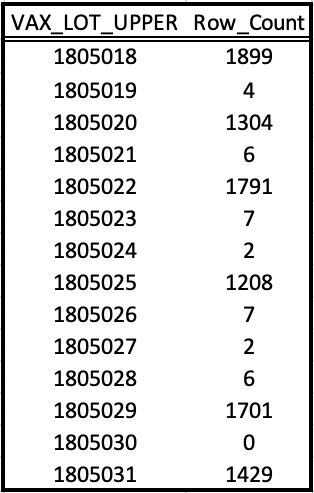Lots scheduled for removal associated with high SAE rates
VAERS is more than useful again...
I received an email from a follower today.
I have written about expired lots here and here and here and here and here and here. Having received this email, I decided to comb through VAERS and find out how many of these particular lots have been reported to VAERS with associated adverse events and list what kinds of adverse events we’re talking about here.
This is what I found.
As you can see, there are many reports for 1805018, 1805020, 1805022, 1805025, 1805029 and 1805031. First of all, these should have all been administered before May 27, 2021 (or August if you consider extension) considering that if the almighty CDC requested non-use, then there should have been non-use.
Let’s check.
Seems like the lots associated with a high number of adverse events were injected after the market removal date. Of all the lots listed associated with a high number of adverse events, all but 1805025 were administered post-market withdrawal.
What was the rate of serious adverse events for each of 1805018, 1805020, 1805022, 1805025, 1805029 and 1805031?
Remember how the VAERS handbook states that 10-15% is normal for an SAE rate as per any list of adverse events?
Seems like a lot more, don’t you think? As in, in all cases.
I wonder if anyone will explain why these lots that were meant to be pulled were injected into people anyway resulting in high rates of serious adverse events? Must be a coincidence.
Safe and effective never felt so safe. And effective.











Dr. Charles Hoffe of BC complained to the College of Physicians and Surgeons of B.C that he was seeing adverse effects with certain lots, which led to an investigation not of the shots but of him. I live in Ontario but on his list was my lot # and I’m injured. I had mine in April/21 so thought it curious that the same lot as mine was given in BC months later.
What happens to the contents of those viles, sorry vials, when they go past their expiration date? One possibility is they become inactive and therefore not dangerous? That result is implied by the CDC statement that expired shots 'may require re-vaccination'. Or it may not (CDC covering all the bases there), depending on 'manufacturers' guidance'. What do Mod/Pfizer say about what happens to expired vaccine material? But these expired vax materials cannot be harmless if injecting them has led to so many serious adverse events. Maybe it's whatever is put into the, uh, vials to extend the shelf life of their despicable contents? What exactly is put into them to extend their shelf life? Also, relatedly, it's hard to believe all six billion, or whatever the number of shots is, were stored under the specified deep-freeze conditions. Maybe the contents are inactivated by higher temperatures? If so, does that make them harmless? Or equally or more harmful? Studies to answer these questions are what HHS/NIH/CDC should be doing now.